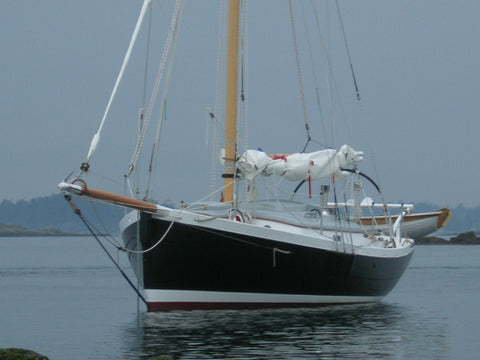Is it up to the builder to decide the placement of the planks in clinker boatbuilding?
The plans do not give the positions of the individual planks. Lining out is the job of the builder and can only really be done in three dimensions. In clinker construction where the plank lines show, it is obviously very important that this be done well and the nice even progression of widths and line is maintained. The only sure fire way of achieving this that I know of is to line out with a series of light battens tacked over the molds to simulate the plank edges. I usually make these battens the width of the plank land (3/4" in the 7 ft Clinker Pram). These are then adjusted by trial and error until a pleasing run of plank lines is obtained and the widths are within permissible limits. Planks in the bottom and topsides can obviously be wider than those in the turn of the bilge because it is important not to go down to a feather edge when dressing off for the next plank. Making an even transition of widths so that it looks right to the eye is the secret and I suppose the art of it. In the 7 ft clinker pram design (Design #80) I have given widths for the keel plank to get you started, and I will usually note the expected number of strakes per side.
One other thing I should mention on the lining out. The type of gunwale has a bearing on the width of the sheerstrake. If there is an outside gunwale at the sheer, the width of this has to be added to the width of the sheerstrake. Otherwise the sheerstrake will look narrow in relation to the planks below. If, on the other hand, there is no outer gunwale, but a rubrail under the land of the sheerstrake, then the reverse is true. The sheerstrake has to be made narrower by the depth of the rubrail in order for harmony to exist in the land. This type of gunwale is common British practice and can be seen in design #86, the 13ft- 6in rowboat. All this is easier to do than describe, but needs to be thought about at the lining out stage. It is the kind of detail that makes all the difference.
Continuing with the 7ft clinker pram, are the transoms to be cut to the inner edges of the planks or to the continuous curves as lofted and shown on the lines?
Now what happens at the transoms? There is no difficulty with the bottom planks or those on the topsides, the problem is how to deal with the planking which lands on the curved surfaces of the transoms. Actually the problem is only really with three or four strakes at the turn of the bilge. Planking in the bottom and topsides will sit comfortably on these relatively flat sections. For the bilge planks there are three possibilities:
- The transom can be trimmed with a sharp chisel to make a flat for each plank to land on. This can only be done progressively as the planks are laid.
- The planks can be bent to fit the curve before being hung.
- A third method is to hollow and round these planks in the manner of carvel.
I prefer the second method, as the result is much better looking and in my view a better demonstration of the boatbuilder's art. We use red cedar for planking here and have no difficulty putting an edge bend in the last few inches of a plank by soaking with a kettle of boiling water and then clamping between curved blocks of wood. This is best done overnight so the thing is dry to fit the next day.
If you were planking with something like mahogany this is not going to be so easy and I would experiment first with scrap wood before deciding on the best approach. If I remember rightly in this little boat it is only the plank lands on the stern transom that require this treatment. The lands at the bow are so much narrower they don't need it.
I have also hollowed and rounded planks in the manner of carvel. To do that you have to leave the plank end thick by backing off the thickness planer gradually as it approaches the end of the plank, and then finish it by hand with a round bottom plane.
I hope this helps. There is plenty of real boatbuilding even in a little boat like this, but at least on this scale if things don't work out right first time it is not all the world to cut a new plank or two.




